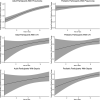Antibacterial Utilization for Febrile Illnesses and Laboratory-Confirmed Bloodstream Infections in Northern Tanzania
- PMID: 37663090
- PMCID: PMC10468737
- DOI: 10.1093/ofid/ofad448
Antibacterial Utilization for Febrile Illnesses and Laboratory-Confirmed Bloodstream Infections in Northern Tanzania
Abstract
Background: We describe antibacterial use in light of microbiology data and treatment guidelines for common febrile syndromes in Moshi, Tanzania.
Methods: We compared data from 2 hospital-based prospective cohort studies, cohort 1 (2011-2014) and cohort 2 (2016-2019), that enrolled febrile children and adults. A study team member administered a standardized questionnaire, performed a physical examination, and collected blood cultures. Participants with bloodstream infection (BSI) were categorized as receiving effective or ineffective therapy based upon antimicrobial susceptibility interpretations. Antibacterials prescribed for treatment of pneumonia, urinary tract infection (UTI), or presumed sepsis were compared with World Health Organization and Tanzania Standard Treatment Guidelines. We used descriptive statistics and logistic regression to describe antibacterial use.
Results: Among participants, 430 of 1043 (41.2%) and 501 of 1132 (44.3%) reported antibacterial use prior to admission in cohorts 1 and 2, respectively. During admission, 930 of 1043 (89.2%) received antibacterials in cohort 1 and 1060 of 1132 (93.6%) in cohort 2. Inpatient use of ceftriaxone, metronidazole, and ampicillin increased between cohorts (P ≤ .002 for each). BSI was detected in 38 (3.6%) participants in cohort 1 and 47 (4.2%) in cohort 2. Of 85 participants with BSI, 81 (95.3%) had complete data and 52 (64.2%) were prescribed effective antibacterials. Guideline-consistent therapy in cohort 1 and cohort 2 was as follows: pneumonia, 87.4% and 56.8%; UTI, 87.6% and 69.0%; sepsis, 84.4% and 61.2% (P ≤ .001 for each).
Conclusions: Receipt of antibacterials for febrile illness was common. While guideline-consistent prescribing increased over time, more than one-third of participants with BSI received ineffective antibacterials.
Keywords: Tanzania; antibacterial use; antimicrobial stewardship; fever; guidelines.
© The Author(s) 2023. Published by Oxford University Press on behalf of Infectious Diseases Society of America.
Conflict of interest statement
Potential conflicts of interest. All authors: No reported conflicts.
Figures

Similar articles
-
Evaluation of in-hospital management for febrile illness in Northern Tanzania before and after 2010 World Health Organization Guidelines for the treatment of malaria.PLoS One. 2014 Feb 24;9(2):e89814. doi: 10.1371/journal.pone.0089814. eCollection 2014. PLoS One. 2014. PMID: 24587056 Free PMC article.
-
Etiologies of illness among patients meeting integrated management of adolescent and adult illness district clinician manual criteria for severe infections in northern Tanzania: implications for empiric antimicrobial therapy.Am J Trop Med Hyg. 2015 Feb;92(2):454-62. doi: 10.4269/ajtmh.14-0496. Epub 2014 Nov 10. Am J Trop Med Hyg. 2015. PMID: 25385866 Free PMC article.
-
Prevalence and predictors of urinary tract infection and severe malaria among febrile children attending Makongoro health centre in Mwanza city, North-Western Tanzania.Arch Public Health. 2012 Mar 16;70(1):4. doi: 10.1186/0778-7367-70-4. Arch Public Health. 2012. PMID: 22958592 Free PMC article.
-
A Systematic Review and Meta-analysis of the Prevalence of Community-Onset Bloodstream Infections among Hospitalized Patients in Africa and Asia.Antimicrob Agents Chemother. 2019 Dec 20;64(1):e01974-19. doi: 10.1128/AAC.01974-19. Print 2019 Dec 20. Antimicrob Agents Chemother. 2019. PMID: 31636071 Free PMC article.
-
Pharmacokinetic characteristics of antimicrobials and optimal treatment of urosepsis.Clin Pharmacokinet. 2007;46(4):291-305. doi: 10.2165/00003088-200746040-00003. Clin Pharmacokinet. 2007. PMID: 17375981 Review.
Cited by
-
Healthcare utilisation for febrile diseases in northern Tanzania: a randomised population-based cluster survey.BMJ Glob Health. 2025 Mar 6;10(3):e017913. doi: 10.1136/bmjgh-2024-017913. BMJ Glob Health. 2025. PMID: 40050036 Free PMC article.
-
Epidemiologic and Genomic Characterization of an Outbreak of Rift Valley Fever Among Humans and Dairy Cattle in Northern Tanzania.J Infect Dis. 2025 Aug 14;232(2):298-307. doi: 10.1093/infdis/jiae562. J Infect Dis. 2025. PMID: 39535803 Free PMC article.
References
-
- Hsia Y, Lee BR, Versporten A, et al. . Use of the WHO Access, Watch, and Reserve classification to define patterns of hospital antibiotic use (AWaRe): an analysis of paediatric survey data from 56 countries. Lancet Global Health 2019; 7:e861–71. - PubMed
-
- Versporten A, Zarb P, Caniaux I, et al. . Antimicrobial consumption and resistance in adult hospital inpatients in 53 countries: results of an internet-based global point prevalence survey. Lancet Global Health 2018; 6:e619–29. - PubMed
-
- Minzi OM, Kilonzi M, Mikomangwa WP, et al. . Update on bacterial and antibiotic susceptibility profiles among patients attending a tertiary referral hospital in Tanzania. J Glob Antimicrob Resist 2021; 25:87–8. - PubMed
Grants and funding
LinkOut - more resources
Full Text Sources

